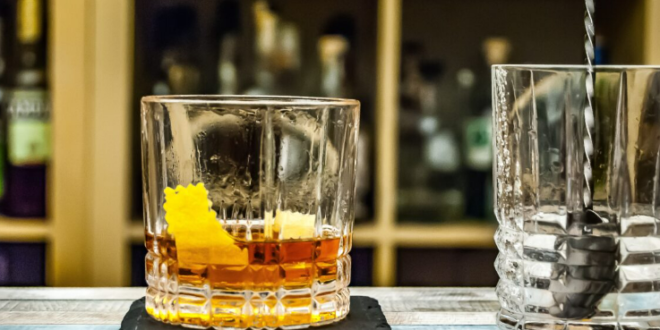A punchy New Orleans cocktail, the Sazerac has a long history but remains a favourite in the Big Easy. We know the Sazerac was invented in New Orleans, but as for the exact bar it was born in?
“There’s no way to know,” says Matt Ray, the cocktail expert at the city’s Sazerac House. “Cocktail history is notoriously fuzzy because not many people cared what bartenders were doing in the mid-19th century. And not many bartenders thought that what they were doing was important enough to catalogue it.”
Of course, we’re now in the midst of a classic cocktail renaissance. Travellers do care about a drink’s provenance, especially a drink as intertwined with a destination as the Sazerac is with New Orleans. Here, Matt takes us on a deep dive into NOLA’s signature cocktail.
The History

“Today, ‘Cocktail’ means a million things,” says Matt. “But in the early 1800s, it meant your spirit of choice mixed with sugar, water and bitters. You could walk into any bar in the city and ask for a ‘gin cocktail’, ‘brandy cocktail’, or ‘whiskey cocktail’, and that’s what you’d get.
“At some point in the 1840s and 50s, bartenders started experimenting with new products from Europe ‒ absinthe, maraschino, curacao ‒ adding a dash or two and making a new category called ‘the improved cocktail’. That’s what the first Sazerac was: a cognac cocktail perked up with a swirl of absinthe. New Orleans was still such a European city in those days, and anise spirits like absinthe and pastis are so culturally important to Europe.”
Winds of Change
Time, politics and the economy all made their mark on the drink over the next century. “As we became a much more American city in the late 1800s, tastes changed,” explains Matt. “Americans began to prefer oaked spirits to cognac; the quality of whiskey also went up following the Revolution. So bartenders started replacing the cognac in Sazeracs with rye whiskey. Another factor was the spread of phylloxera in Europe in the mid-1800s, destroying the grapevines that produced brandy and driving up prices.”
Then, another twist ‒ absinthe was banned in 1912 for its supposed hallucinogenic properties.
“The product that replaced it was called herbsaint,” says Matt, “another anise spirit which is almost indistinguishable.” Prohibition in the 1920s and 30s naturally had an impact, but for Matt, the real Dark Ages for the cocktail were the 70s and 80s. “That’s when classic cocktail culture kind of died off, and everything became a mudslide or a Piña Colada. But New Orleans was still famous for hanging on to traditions like the Sazerac.”
A Timeless Classic

These days, the Sazerac beloved aperitif that New Orleanians still offer to family and friends. In terms of enjoying it like a local, Matt advises, “People usually drink it before dinner. It has a reputation for being the first drink you should have in the city ‒ I know a lot of people who make a point of having one right when they get into town. The locals also tend to have one around Mardi Gras, and Christmas.”
How you drink it also says something about you. “You can sip it slowly, so it opens up as it warms in your hands, or you can throw it back heroically,” says Matt. “You’ll see them on a lot of happy hour menus because it’s so quick and simple to make.” Despite its short stature, vintage nature and simplicity, young New Orleanians still order it in bars across town. “People here don’t shy away from things their grandparents used to drink,” observes Matt. “Rather, the opposite: they find it kind of charming.”
The Recipe for this Famous New Orleans Cocktail
“First, you take two rock glasses ‒ ideally a bevelled rock glass, if you want to get specific ‒ and you chill one of them. In the other, you throw in a sugar cube, or a quarter-ounce of simple syrup if that’s easier. Add three dashes of Peychaud’s Bitters and muddle that with the sugar, then add an ounce and a half of rye whiskey (I usually give that a quick stir to help dissolve the sugar).
“Next, you add ice and give it a brief stir, then set that glass aside. Take the glass that’s been chilling, dump out the ice and add a splash of herbsaint or absinthe. Swirl it around the glass ‒ then either drink it or throw it out. Take your whisky mix and pour it slowly into that chilled herbsaint glass. The last step is to squeeze a twist of lemon peel so it sprays a little lemon oil. I then either throw in the twist or use it to decorate the glass.”
If you want to go old-school, advises Matt, make it with the original spirit, cognac. “The clove-peppercorn notes of rye are traded out for these rich, raisiny dark fruits. It’s a little bit more flowery and aromatic.” In terms of what can go wrong? “One of the worst I’ve ever had was completely green because it was probably half absinthe. It’s supposed to be a hint of liquorice or anise, not a punch in the face. And I once saw someone add Sweet’N Low instead of sugar.”
Sazerac Stars
Okay, so we’re visiting New Orleans. Where should we go for that first? “You could come down to the Sazerac House and take a cocktail-making lesson, or visit the museum exhibits we have. But in terms of a straight-up bar, I love Peychaud’s Bar in the French Quarter, which specializes in New Orleans classics like the Ramos Gin Fizz and the Vieux Carré (like a supercharged Manhattan). Otherwise, I’d recommend a bar called Jewel of the South, and a little dive downtown called Bar Tonique.”









Join the Discussion
Type out your comment here:
You must be logged in to post a comment.